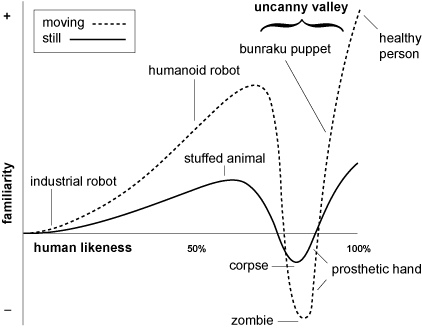Motion tech still far behind

Here is a visual representation of the uncanny valley and how it affects humans.
October 31, 2012
Motion controls seem to be the next big trend with console developers. Ever since Nintendo introduced the Wii in 2006, Sony and Microsoft have been trying to replicate the Wii’s success with the Playstation Move and the Kinect, respectively. However, motion controls will not last long, due to a psychological effect called the uncanny valley.
The uncanny valley was first proposed by Japanese roboticist Masahiro Mori in 1970 when referring to how people treat humanlike robots.
When robots exhibit no human characteristics, like industrial assembly robots, people do not have any strong feelings about them. However, once a robot starts gaining human characteristics, people start to sympathize with them. This is why the main character from Pixar’s “Wall-E” is so endearing; Wall-E is clearly not human, but because of his human characteristics, people sympathize with him. This is the first rise in the graph.
As Mori started adding synthetic skin and rudimentary facial expressions to his robots, the people he showed his robots to suddenly felt uneasy around them, since the robots looked almost, but not quite, human. Mori labeled this extreme plummet in sympathy “the uncanny valley.”
The uncanny valley isn’t just limited to robots, however. Motion controllers have this same effect on the player’s body.
The human body knows what certain actions feel like. Obviously, pushing a control stick forward to make your in-game character run forward does not make the player’s body run forward in real life. Because there’s no connection between the real-life motion and the in-game motion, the player can completely delve into the game without noticing the controller.
When the movement required in reality to move a character in a video game starts to resemble the same movement in that game, the player’s suspension of disbelief breaks. Running in place to make a character run in-game is close enough to, but not quite the same as, the actual movement to jar the player out of the game.
For example, the Sega-developed game, “Rise of Nightmares,” was specifically designed for the Kinect, so one would expect the controls to feel as natural as possible. To move forward, the player puts one foot forward and turns by turning his or her shoulders. At the beginning of the game the movement is distracting and cumbersome and although that feeling lessens, it never entirely disappears.
Even the most popular motion control console, the Wii, has similar issues. When playing “Wii Sports,” none of the actions required feel like the actions they’re simulating. The most effective way to bowl involves using two hands, a technique that would be very difficult, if not impossible, to replicate in reality.
This phenomenon demonstrates the uncanny valley can be applied to video game controls as much as to robotics. Right now, motion controls reside in the uncanny valley and the technology does not exist to rectify it.
Getting out of the uncanny valley is extremely hard, but once current technology has advanced far enough to allow such a thing to happen, video game controllers will become incredibly effective at immersing players into the game they’re playing.
Haptic, or touch, feedback technology will be the first key to climbing out of the valley. When the player can actually feel what the character onscreen is doing, with a high amount of accuracy, that is the moment when the suspension of disbelief will become much stronger than with a simple controller. Current technology can only create vibrating controllers, which helps contribute to player immersion, but nearly as much as haptic feedback has the potential to. However, even if haptic feedback could perfectly replicate how something feels, it cannot recreate motion.
The ideal technology to accurately recreate motion would be a complete virtual reality simulator which transmits sensations directly into a person’s nervous system. Such a technology would be revolutionary, not only for games, but for education, diagnosing psychiatric disorders and a host of other benefits.
Obviously virtual reality and accurate haptic feedback are still decades away from being developed. Because of this, current motion controls are too primitive for effective gaming. The controller is still the best medium with which to play video games, and will be for a long time yet.
Nick can be reached at: [email protected]




























































































































